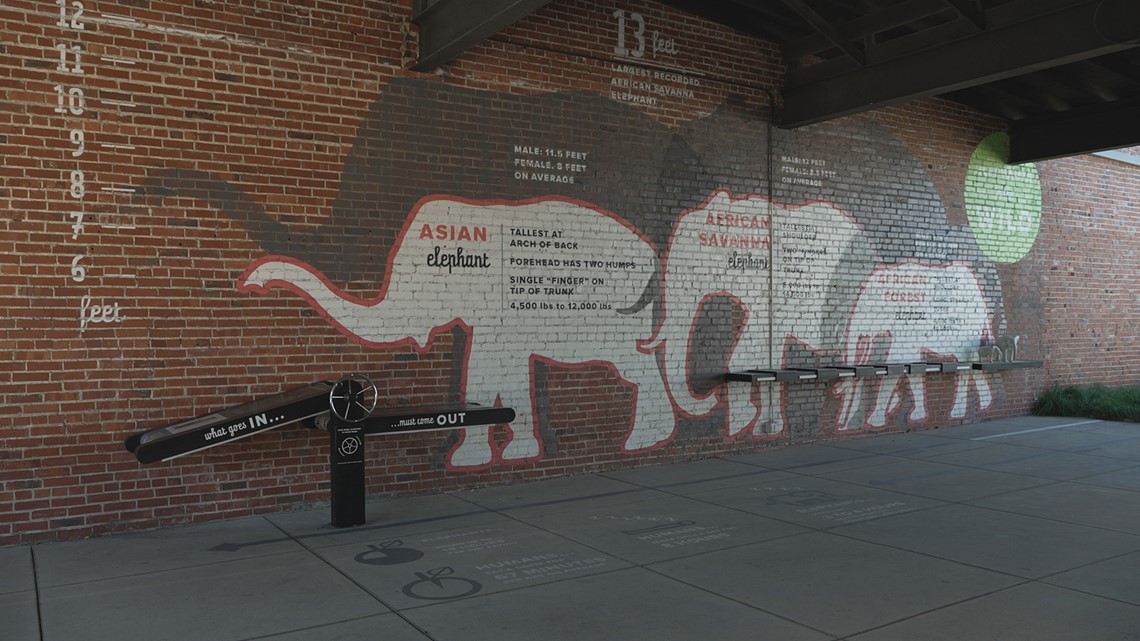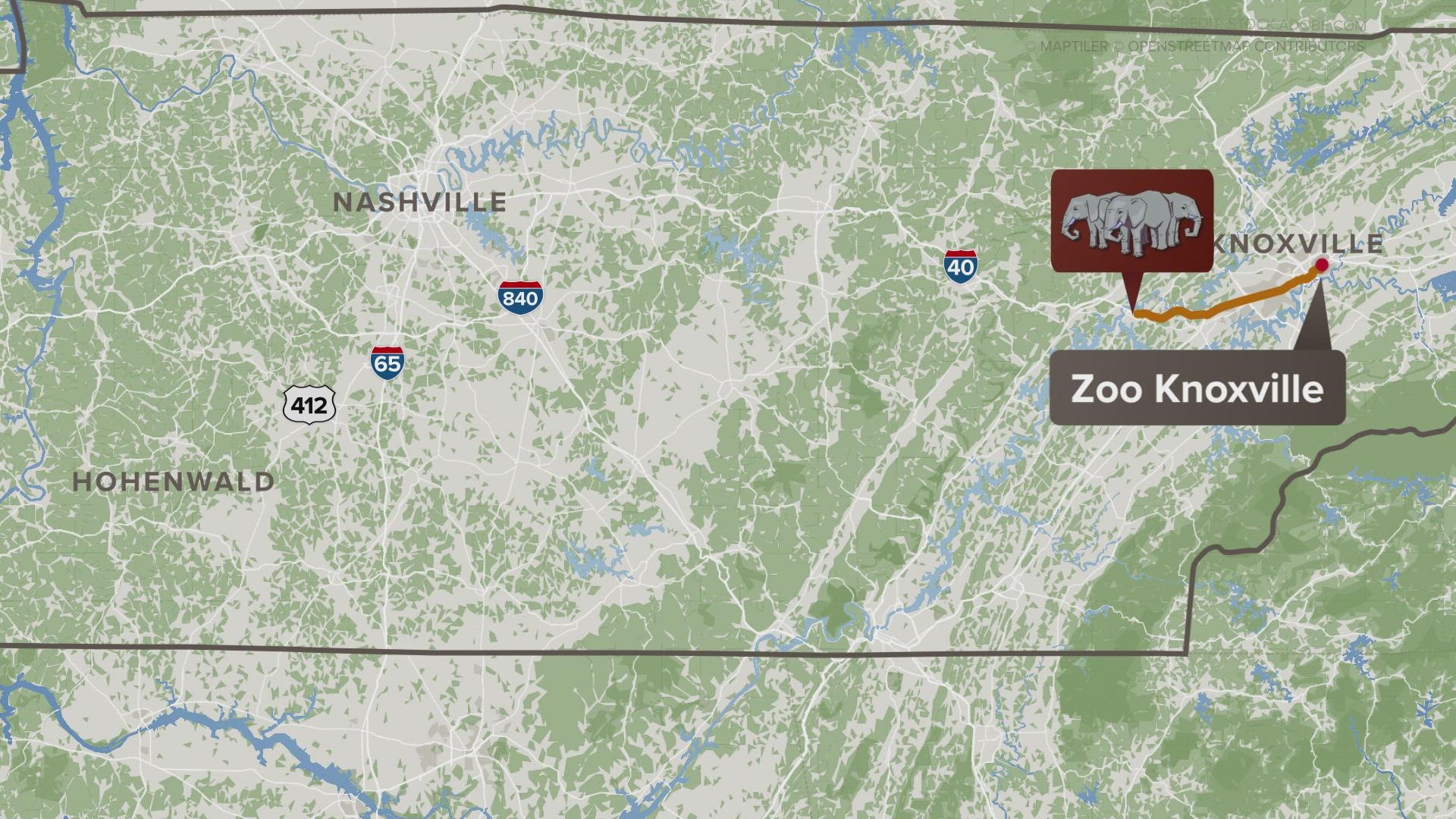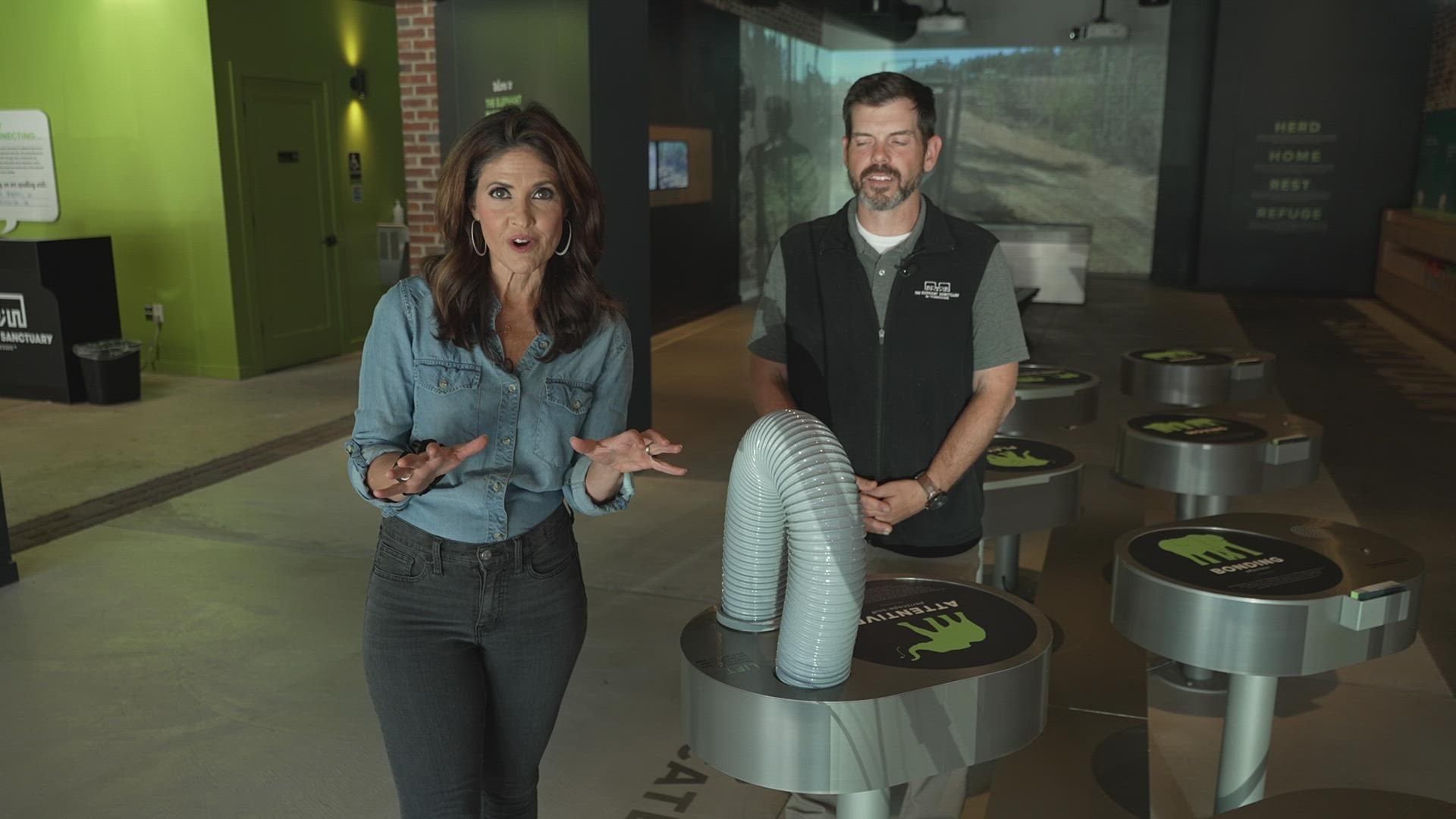Knoxville to Hohenwald: Aging Zoo Knoxville elephants will find refuge at the Elephant Sanctuary
Tonka, Jana and Edie — all aging elephants — will find refuge in Hohenwald, a small city in Middle Tennessee.

For around seven decades, Zoo Knoxville has hosted elephants. Visitors would flock to see their stomping grounds, featuring some of the features native to their homeland in Africa.
But soon, the zoo's animals will trade the spotlight for around 3,000 acres of refuge at the largest elephant sanctuary in the U.S. It's just four hours from Knoxville, located in Hohenwald. It's a small city located in Middle Tennessee where the elephants will be able to enjoy wide open spaces.
Soon, the Elephant Sanctuary there will welcome Tonka, Jana and Edie as they leave the zoo behind. They will be given top-notch care and still have companionship as they age in the sanctuary's wide-open fields.
A Century of Elephants on Rocky Top Elephants walked down Gay Street a century ago
Walking through downtown Knoxville, it's hard to imagine the streets once hosted elephants. But in around 1890, the circus brought elephants and paraded them past the city's now-historic buildings.
More than half a century later, in 1963, the Ringling Brothers Circus gave Zoo Knoxville a male African Elephant named "Old Diamond." He was later joined by two female elephants.


Fifteen years later, history was made in Knoxville. Little Diamond was born — the first ever African elephant born in the western hemisphere. Years later, she was taken to the North Carolina Zoo in the hopes that she would breed with the zoo's other male elephant.
She later passed away in 2014 from an impacted large intestine from eating too much sand, according to reports in the North Carolina area. Her father, Old Diamond, died in 1980.
In 2002, Knoxville met some new elephants — three to be exact. The Stokely African Elephant Preserve at Zoo Knoxville welcomed Tonka, Jana and Edie.
Tonka, Jana and Edie Three iconic elephants arrive in Knoxville
Tonka is the oldest of the bunch and he is the second-oldest African male elephant in the U.S. He arrived in the city in 1981, when he was three years old. He weighs around 15,500 pounds and is around 11 feet tall, at the shoulder.
He's not only the oldest of the bunch. He's also the biggest.
Jana is a 42-year-old female who arrived in Knoxville from the Louisville Zoo in 1998. She weighs in at around 10,000 pounds and is around 9 feet tall.
Her companion is 39-year-old Edie, another female African elephant. She arrived in Zoo Knoxville in 2002 and is the smallest of the bunch, at around 9,500 pounds and standing around 8 feet tall at the shoulder.
Elephants March from Zoo Knoxville A journey of around 250 miles
Zoo Knoxville partnered with the Elephant Sanctuary to give the three elephants care and companionship as they age. Part of that care is letting the elephants decide when they should leave the zoo.
First, the elephants need to acclimate to their travel crate. Jana and Edie will lead the way, hopefully within the next six to eight months. Zoo Knoxville hopes all three will be reunited at the Elephant Sanctuary toward the end of 2023.
”Our elephants are advancing in years," said Lisa New, the CEO of Zoo Knoxville. “In fact, they are approaching the end stages of their life.”
Zoo Knoxville plans to give the community plenty of opportunities to say goodbye and celebrate the elephants. Edie will turn 40 years old this year. However, fans don't need to say goodbye to elephants at the zoo forever.
Leaders at Zoo Knoxville said they plan to one day bring in new elephants.
“There’s a little bit of grief in losing them, even though we know that this is in the very best interest of them moving forward," said New.
The Elephant Sanctuary Herd, home and rest
It’s not the scene most people expect in a secluded small town in Middle Tennessee. Elephants roam freely in wide open spaces finding herd, home and rest.
“We love using the term retired for the elephants living here because that's exactly what we want to provide,” said Todd Montgomery, Senior Manager of External Relations at the Elephant Sanctuary. “The Elephant Sanctuary is truly just a space for them, dedicated to them."
Since 1995, the Elephant Sanctuary has provided refuge to 28 elephants born in the wild but raised in captivity in circuses, carnivals, zoos and even museums. Here, elephants experience life beyond entertainment and education. It’s a true sanctuary away from the spotlight.
“Our long-term goal is to get them as much to the wild as possible,” said Kristy Eaker, senior manager of Elephant Care. “Giving them that more social dynamic, close to a herd as possible, all while giving them the free choice of where they go and how they spend their day.”


There are three different habitats at the sanctuary. Nine elephants ranging in age from 37 years old to 60 years old live at the refuge.
“Debbie is actually one of our younger elephants, she's 51. Minnie and Ronnie are 53 years old,” said Eaker. “So they will spend the rest of their days together as a trio going back and forth wherever they want to go.”
Even though the sanctuary is the nation’s largest, natural habitat refuge for elephants — the transition isn’t immediately “natural” for the animals.
“The first couple weeks, you might see them hanging more closely to the barn because it's a comfort zone,” said Eaker. “It’s obviously a different space for some of these animals that are coming in from smaller areas or just other social opportunities. So, you know, we really try to take them under our wing and give them as much time as they need to adjust and make those acclamations.”
New elephants at the sanctuary are paired with an elephant mentor. Enrichment helps them build curiosity and confidence.
“Learning how to push a tree down or learning to walk up a hill or down a steep hill. We'll see them make those transitions and, a lot of times, the other elephants will really help with that,” said Eaker. “Seeing them take those huge steps to become independent is really what we're looking for.”
While you can’t visit the Elephant Sanctuary's 3,000-plus acres, you can watch the elephants in three different habitats thanks to cameras placed throughout the area.
Three of the 13 cameras called “Elecams” are live online every day. Caretakers move cameras daily to capture elephant activity, whether it’s eating or just enjoying their surroundings.
The sanctuary also just opened a new elephant lab on site, with a full-time veterinary staff and around-the-clock care.
“We can do our own blood work or fecal examinations, any type of lab analysis,” said Eaker. “These elephants are very spoiled.”
The elephants live their best days in peace, quiet and companionship even after they’re gone.
“They are part of our family and so anytime they do pass, we do have a memorial for them. We have stones on the grounds to represent each individual and we always have a memorial service with the staff," said Eaker.
The Elephant Sanctuary is one of two accredited elephant sanctuaries in North America and the only one certified by the Association of Zoos and Aquariums.
The Elephant Discovery Center Downtown Hohenwald's public attraction
The Elephant Discovery Center is a public attraction in downtown Hohenwald, located just off the Natchez Trace, a historic 444-mile trek from Nashville to Natchez, Mississippi.
The tiny Tennessee town shy of just 4,000 people is the last place you’d expect an encounter in the wild.
But here, it happens daily.
“Hohenwald, I wouldn’t describe it as a big place,” said Montgomery. “Our visitors are able to observe the elephants displaying natural behavior in a natural setting."
Visitors can connect with elephants roaming rural acres not far from the Discovery Center. And the staff are always happy to talk about the elephant in the room.
“Elephants are extremely intelligent animals with a wide range of behavioral, emotional, mental, and physical needs — all of which change and evolve as they get older based on what happens around them,” said Montgomery.
Through site, sound and state-of-the-art technology, the gentle giants come to life. Hands-on, self-guided exhibits fill the gallery and offer a different kind of trunk show.
The Elephant Discovery Center even has an almost life-sized puppet. It’s not uncommon to see it parading down Main Street or through the center’s outdoor classroom.
“We were able to fill in that space with some education exhibit so that as people walk through, hopefully, they learn something that sticks with them about elephants,” said Montgomery.
And of course, visitors can’t resist posing and snapping a selfie with the elephant sculpture named “Re-TIRED.” It’s made completely of recycled tires.
Those who can’t make the trip can learn from afar thanks to the virtual lab.
“Last year in 2021, we were able to interact with around 14,500 virtual learners all over the world,” said Montgomery. “I think in 16 different countries and 30 different states here in the United States."
The center also has an interactive timeline and a digital map of the Elephant Sanctuary's barns and habitats. Visitors can read about the life history of each elephant that lived there, and also take a virtual tour of the grounds.
The Elephant Discovery Center has welcomed 5,000 visitors since 2019.






